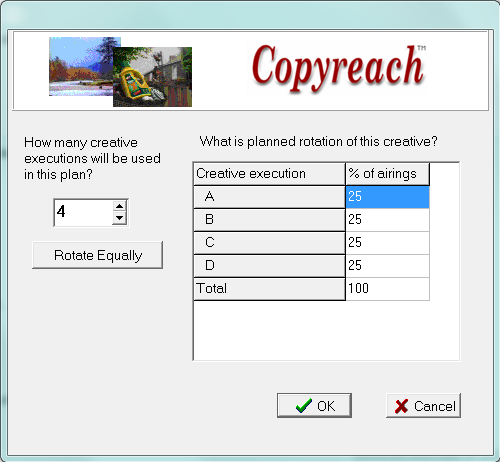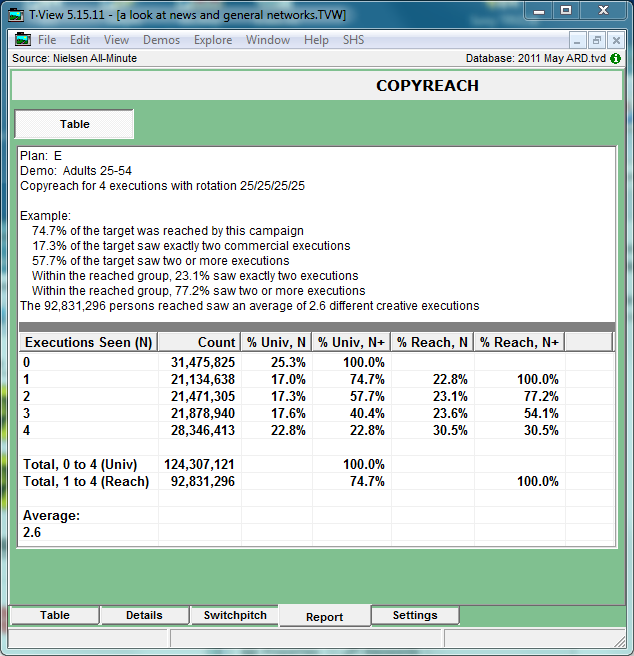Copyreach™
Copyreach™ is a novel and unique way of looking at a plan's performance. Instead of thinking about how many times a person sees our campaign, Copyreach asks how many different creative executions were seen?

A client’s campaign has a solid central theme, which is expressed through multiple creative executions. But are there enough executions? Too many? How many different approaches will viewers actually be exposed to? Are too many viewers seeing only one or two executions? Can a budget be justified by showing that weight is necessary to build exposure to multiple messages?
Consider this television plan, and the results that TView has estimated for it:
We have learned that this schedule will reach 71.5 percent of our target. On average, each person reached will have seen our campaign 5.1 times.
Now consider the commercial pool question: How many different creative executions do we need? Many factors will go into this decision. Some of these concerns are:
| • | Is there a concern about wearout? If so, more executions might be necessary. |
| • | Will more executions help keep the campaign fresh? |
Many media professionals help provide judgments on these issues by examining the average frequency, and the delivery to exposure quintiles (as shown in TView's Details view).
Another issue can come up that is even trickier:
| • | Might the campaign be completely misunderstood if only one or two executions are seen? |
Examples
Here are some situations where Copyreach could be useful::
| • | A campaign for a small airline features a different destination in each execution. If a viewer sees only one or two, he or she may get the impression that the airline offers few destination choices. |
| • | A campaign envisions executions that feature different sports, football, baseball, hockey and so on. An account exec worries that if too many people see only one of these executions, they might think we are somehow tied to that sport, perhaps with an official sponsorship, and since we don't that could put us in legal jeopardy. |
| • | The H&R Block tax tip series ("Number 37") only makes sense if you've seen two, three or more executions and thus can recognize that there are, in fact, many ways that this company might be helpful with your tax return. |
| • | A food condiment campaign shows its use in different dishes, each presented in its own creative execution. Seeing only one spot may suggest that its use is limited to that meal. |
| • | A product has a number of distinct and desirable features, and each execution explain one of them: it has an automatic timer, it comes in many colors, it can do two things at once, it folds up for easy carrying. If several executions are seen, the campaign's message is that it does several things very well. |
| • | A "mini-series" theme in which a continuing story develops through on-going characters, may need to have at least a majority of the executions seen. The classic of this approach years ago was a Taster's Choice campaign described in interesting articles here and here. |
Now here is the key thing: In each of these cases, knowing the frequency or the frequency distribution is not enough to address the concern. For example, a viewer may have seen the campaign ten times, but each time saw the exact same creative execution!
Using Copyreach
TView provides a novel way to study such situations through its Copyreach command. To start, enter you schedule as usual. Then, select the plan by clicking on the plan header. Choose the "Copyreachª" command on the Special menu.
Enter the number of creative executions being planned into the Copyreach dialog. You are also able to specify the rotation pattern among creative executions:

Finally, TView analyzes the schedule and prepares a report. The report includes text examples of how to read the report.

In the above, we learn that just over a fifth (22.8%) of the people who are reached will see only a single spot. While we got an overall reach of 74.7%, only 57.7% of our target will see two or more different creative executions.
How Does Copyreach Work?
Everything in TView is done respondent-by-respondent. (See more here: How TView Works.) This gives enormous flexibility in deciding how and what we choose to count. Since the mechanism is that we're taking spots (one by one) and throwing them at the respondents (one by one), we can keep track of anything that we think might be interesting. Mull that one over!
So, when we're looking to see whether projected spot #12 hits respondent #17654, we are certainly able to say that spot #12 is a certain creative execution, and then count how that plays out accordingly. Do that for each of the spots, and we can keep track of how many executions each respondent has seen.
There is a little additional magic in there to solve some technical issues, for example, to make sure that the percentages assigned to each creative are observed even if the spot count doesn't quite fit, and to make all of this happen in a speedy way. The key is that we're taking advantage of the respondent-by-respondent nature of the whole process.
